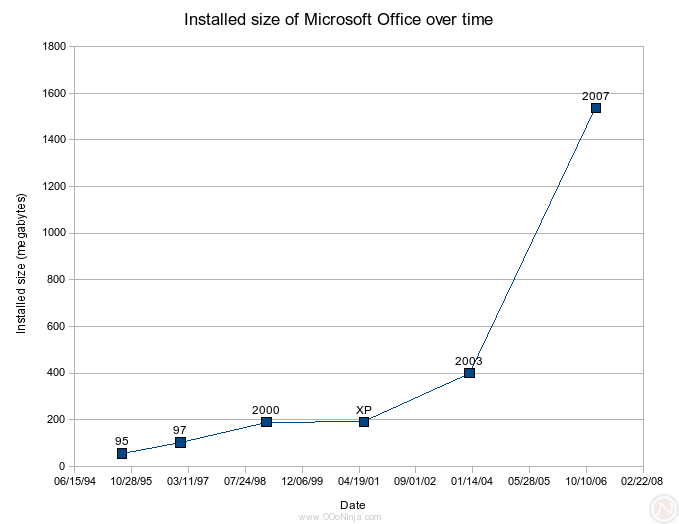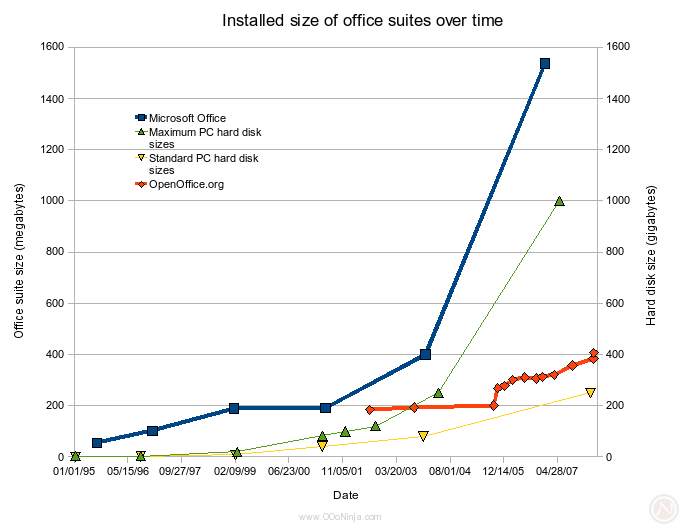Earlier we challenged Moore's Law with OpenOffice.org. Today we have a three-way match. In the first corner, we have heavyweight Microsoft Office; in the second, undefeated champion Moore's Law; in the third corner, underdog OpenOffice.org. Let's get ready to rumble!
Again we are measuring the installed disk usage of each release. Because old versions of Microsoft Office are not as accessible as OpenOffice.org, the sizes are based on system requirements printed at the microsoft.com web site—a site which is remarkably thorough. Another complication is Office's numerous editions. The number of editions has ballooned from a 2 in Office 4 (1994) to a confusing 9 in 2007. While all editions have Word, each edition has a different set of other products such as Access, Outlook, and Visio. Which should be measured? I used the printed values for the typical installation size for the Standard versions. Release dates are courtesy of Wikipedia.

The Microsoft Office data points fits an exponential curve remarkably well with R2=0.94. At this rate of growth, Microsoft Office Standard 2013 will be 5000MB, and the Microsoft Office Premium Platinum Plus 2013 edition (a larger edition than the Standard edition) will come on a set of Blu-ray discs.
The next chart combines the Microsoft Office installations, OpenOffice.org installations, standard (meaning new but modest) PC disk sizes [1], and maximum PC disk sizes. Watch out for the double Y axes: megabyte scale for disk usage and a gigabyte scale for disk capacity.

Inspection indicates Microsoft Office Standard editions growth more closely in step with maximum disk capacities while OpenOffice.org more closely follows standard disk capacities. That means each Microsoft Office version consumes a larger percentage of a contemporary hard drive.
Extrapolation estimates OpenOffice.org will reach 1000MB around the year 2024 and it will never exceed Microsoft Office's size. However, if the OpenOffice.org 3.0 standard edition bundles additional applications (such as Thunderbird and Lightning), the trend will change. Thunderbird 2.0 would add 44MB (11% of OpenOffice.org 2.4.0).
Related articles
This is second in a series on OpenOffice.org performance. Subscribe so you don't miss anything. :)

16 comments:
I don't find taking more space a problem. But just if it gives additional value. For example it whouldn't be crazy to include a big clipart gallery with OpenOffice and whould take a lot of space. Some sort of bundled openclipart ;)
I guess clipart adds bias to the weight.
Did you really mean 5,000GB by 2013? That's quite an exponential curve. 5GB would be a lot; 500GB would be astonishing, but 5 terabytes? Also, that doesn't jive with the comment about blu-rays.
Buho: Yes, disk space is cheap and not a problem. I meant this article from an academic and curious point of view.
RTC: Yes, I meant 5000MB. I fixed the typo. Thank you. The comment about Blu-Ray was partially a joke. I made up the Microsoft Office Premium Platinum Plus edition, but in truth, Microsoft Office frequently introduces new products and new editions. I clarified the article to distinguish the 5000MB from the Blu-ray: they are referring to different editions of MSO.
I thought that was what you meant. 5,000 GB just seemed a little over-the-top :)
Love the blog, by the way!
Hi - great comparison, thanks!
I have a question about the bottom chart, though, which shows maximum hard drives as being 1TB in space, but MS office taking up 1.5 TB?
Is there a scale issue on that graph that I'm not seeing?
Aha, sorry, yes - I see it now.
Megs on the left, Gigs on the right.
It's still off-putting seeing office take up 1.5 hard drives ;)
Buho: OxygenOffice Professional has. (ooop.sf.net)
5000MB would fit on a DVD by 2013.
I know the Blu-ray thing is just a joke.
The Blog is still good though.
They should make a Microsoft Office Ultimate Premium Diamond Plus Deluxe Best Edition starting at just $4999.95. :D
It sure as hell better not be 5K in price.
I installed Office 2010 Professional Plus earlier today, and it looks pretty good. Im wondering what the pricing is going to be like when Microsoft officially releases it.
Either way, im not gonna pay the absurd amount of money that Microsoft charges for it, but ill still download and get it.
I have a simple question. Will Open Office fit on a normal CD. IF so, how much space will it take up? I want to basically just have someone use IMPRESS with a template that I built in impress. So there is no need for the entire package (if it can be stripped down a little etc. Would like to discuss further with possibly some help too.
Take care.
Patrick:
All of OpenOffice.org easily fits on any CD, but it sounds like you are trying to run it from the CD without installing it on the hard drive? Also, there is not much to be gained by stripping down OpenOffice.org because its bulk is in the common components. (Removing the spreadsheet, for example, will regain little space.)
Thanks Andrew for the info. Can it be run from the CD? I suspect not, anything that would simplify using the IMPRESS program for an hour or so. There's pros and cons in using this versus PowerPoint I guess, some people will have PowerPoint installed and know it and use my template but if you supply them with Open Office, everyone can be a potential customer but will need to download and follow my mini instructional video which would work for either program.
Thanks again for any insight, Happy 4th!
Your graph indicates that while size increases it doesn't do so in a predictable manner.
If Moore's law was applied to cars fifty years ago, the estimation for today's speed would be 1,000 MPH.
Once a plateau is met for one facet of a product, other facets become the focus of improvement.
Once cars made it obtainable to reach speeds over 100 MPH, we then focused on safety, and then gas mileage.
This I would like to call Roy's Law, but more likely to be called something like Sloth Law. Everything is too lazy to keep doing something forever. (which is my explanation why nukes do not destroy the planet. FYI In theory one nuke should start a nuclear chain reaction, and burn the whole planet before stopping.)
Another thing, as the article infers, developers for OpenOffice has free will, and is working on keeping it lean.
Are we to believe that Microsoft is any different? Are they using a million monkeys working for a million years?
;-))
I'm wondering whether you are planning on updating this, and for sizes for x64 and x86 :D
I can try provide you some data points. =)
Post a Comment